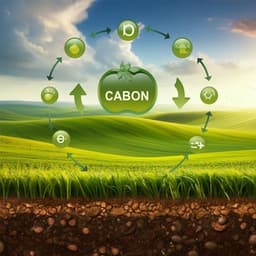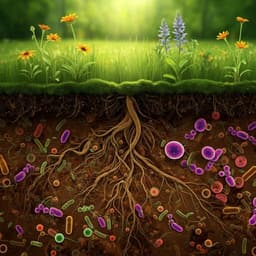
Environmental Studies and Forestry
Permaculture enhances carbon stocks, soil quality and biodiversity in Central Europe
J. Reiff, H. F. Jungkunst, et al.
This study reveals the remarkable benefits of permaculture, showcasing significant improvements in soil carbon stocks, quality, and biodiversity across Central Europe. Conducted by a team of researchers including Julius Reiff and Hermann F. Jungkunst, this research highlights permaculture as a promising approach for sustainable farming.
~3 min • Beginner • English
Introduction
The study addresses how permaculture, as a holistic agroecological design and management framework, affects soil carbon storage, soil quality, and biodiversity compared to locally predominant agriculture in Central Europe. The context is urgent global environmental challenges—soil degradation, biodiversity loss, and climate change—where agriculture both contributes to and is impacted by these pressures. Increasing soil organic carbon is a key mitigation pathway (e.g., the 4 per 1000 initiative), improving yield stability and resilience. Efficient nutrient use, especially phosphorus, and maintaining agro-biodiversity are essential for sustainable production and ecosystem services. Agroecology and permaculture share principles such as enhancing diversity, nutrient cycling, building soil and water storages, and integrating land-use elements to create synergies. Despite widespread practitioner adoption, scientific evidence on whole permaculture systems remains limited, especially in temperate, commercial contexts. This study tests the hypothesis that permaculture systems, due to integrated, context-specific practices, improve soil carbon stocks, soil quality, and biodiversity relative to conventional regional systems.
Literature Review
Agroecology is endorsed by FAO as a pathway toward the SDGs, emphasizing diversity, circularity, and social dimensions. Permaculture overlaps with agroecology but emphasizes conscious, site-specific systems design to integrate practices (e.g., agroforestry, crop-livestock integration, semi-natural habitats) and foster regenerative outcomes. Prior literature documents benefits of individual practices (agroforestry, diversified farming, semi-natural habitat promotion) for soil carbon and biodiversity, yet agroecosystems function as complex systems with interactions that may yield additive or synergistic effects beyond isolated practices. There is a lack of empirical studies on whole, operating permaculture or multi-practice agroecological farms in temperate regions. Meta-analyses on agroforestry and other practices show variable effects on soil carbon, bulk density, and biodiversity, but evidence is mixed and often not directly comparable to integrative, whole-farm systems. This gap motivates evaluating permaculture as a systems approach rather than the sum of practices.
Methodology
Study design: A paired-site observational study was conducted at nine permaculture sites (eight in Germany, one in Luxembourg) from 2019 to 2021. Each permaculture site was paired with a nearby (≤3 km) control field representing locally predominant agriculture to ensure similar climatic and geologic conditions.
Site selection criteria: (1) Designed and managed according to permaculture principles; (2) Economically self-sufficient production; (3) Integration of at least two land-use practices (spatially, temporally, or indirectly) to create synergies. Permaculture sites represented whole farms or parts of farms, with varying land-use types (e.g., vegetables, arable crops, grazing, grassland, tree crops).
Sampling: At each permaculture site, one field per land-use type was sampled (minimum field element 400 m²). One corresponding control field was sampled per site. Sampling occurred mid-May to early June. Soil samples were taken at three points per plot (0–10 cm and 10–30 cm depths). Undisturbed cores (5 cm diameter, 5 cm height) were taken at ca. 5 and 20 cm depth for bulk density and water content. Humic topsoil depth was determined up to 1 m with a Pürckhauer sampler. For biodiversity, vascular plant species richness was surveyed in a 100 m² plot per field; earthworms were hand-sorted from a 30×30×20 cm soil monolith per sampling point (20 min each) and identified to species where possible; birds were recorded with an AudioMoth recorder three times (sunrise, +1 h, sunset), species identified from audio, and detections filtered to likely ≤70 m based on sound level (>-35 dB). Tree cover proportion on farms was quantified. Farmer interviews captured farm characteristics, practices, marketing, and land-use histories.
Laboratory analyses: Soil pH (CaCl2), soil organic carbon (Dumas), total nitrogen (Dumas), plant-available P and K (CAL extraction; photometric), Mg (CaCl2 extraction; ICP-OES), and micronutrients B, Cu, Mn, Zn (CaCl2+DTPA extraction; ICP-OES). Weighted means were calculated across 0–10 and 10–30 cm to represent the top 30 cm. Soil texture was classified by feel into seven classes.
Microbial community: PLFA analysis (Bligh and Dyer method with modifications) on freeze-dried 0–10 cm soil quantified total PLFA (proxy for viable microbial biomass) and biomarkers for bacteria, fungi, AMF, and protozoa; ratios (fungi:bacteria; AMF:saprophytic fungi; Gram+:Gram−) were computed.
Derived variables: SOC stocks (0–30 cm) computed from SOC concentration, bulk density, and depth. Carbon sequestration was roughly estimated using a model with permaculture age, assuming paired sites had originally equal SOC and that control SOC did not change; only six site pairs with matched land-use histories were used.
Comparative datasets: Soil indicators compared to German national soil inventory data for arable and grassland; biodiversity indicators compared to a European-wide dataset of conventional and organic farms; tree cover share computed across farms for comparison.
Statistics: Generalized linear mixed models (glmmTMB) with management as fixed effect (permaculture, control; plus levels for added datasets: arable/grassland or conventional/organic). Random factors: location; for soil variables, texture class and pH (except for SOC and total N, where pH was omitted). Response family chosen based on diagnostics (gaussian, Poisson, genpois, nbinom1/2, beta/ordbeta, Tweedie). Significance tested via Type II Wald χ²; post hoc pairwise comparisons with Tukey correction (emmeans). Model-predicted means and 95% CIs were generated (ggeffects).
Key Findings
- Soil organic carbon (SOC) and stocks: Permaculture sites had 71% higher SOC concentration (3.4 ± 0.3 g/100 g) vs controls (2.0 ± 0.3 g/100 g), 94% higher than average German arable (1.8 ± 0.2 g/100 g) and 18% higher than average German grasslands (2.9 ± 0.2 g/100 g, trend). SOC stocks (0–30 cm) were 27% higher on permaculture (87 ± 9 t/ha) vs control (68 ± 8 t/ha), and 37% higher than average German arable (62 ± 3 t/ha); similar to average German grasslands (90 ± 4 t/ha). Humic topsoil depth was 59% greater on permaculture (45 ± 4 cm) vs control (28 ± 2 cm).
- Estimated sequestration: Assuming equal initial SOC and no change in controls, estimated SOC sequestration in 0–30 cm was 0.82 ± 0.39 t C ha⁻¹ yr⁻¹ (significant regression).
- Soil nutrients: Total N was 63% higher on permaculture (354 ± 53 mg/100 g) vs control (217 ± 33), 138% higher than German arable (148 ± 18), and 48% higher than German grasslands (240 ± 29). C/N ratio on permaculture was 9.3 ± 0.6 (10% higher than controls; 13–16% lower than German arable/grassland averages). Plant-extractable nutrients: P by trend +41% (7.3 ± 3.1 vs 5.2 ± 2.1 mg/100 g), K +123% (30.6 ± 7.1 vs 13.8 ± 3.5 mg/100 g), Mg +66% (17.5 ± 2.4 vs 10.5 ± 1.6 mg/100 g). Micronutrients: B +51% (0.56 ± 0.13 vs 0.37 ± 0.09 mg/kg), Zn +80% (7.6 ± 1.5 vs 4.2 ± 0.9 mg/kg); Cu and Mn not significantly different. Soil pH ~6.2 on both.
- Soil physical properties and moisture: Bulk density (10–30 cm) was 20% lower on permaculture (1.08 ± 0.05 g/cm³) vs control (1.36 ± 0.05 g/cm³), and lower than German arable (1.43 ± 0.03) and grasslands (1.35 ± 0.03). Gravimetric soil water content higher on permaculture (31 ± 4%) vs control (21 ± 3%); volumetric moisture showed a positive trend (30 ± 4% vs 27 ± 3%).
- Soil biology: Earthworm abundance was 201% higher on permaculture (153 ± 57 m⁻²) vs control (51 ± 21 m⁻²), and higher than European organic (50 ± 7 m⁻²) and conventional (36 ± 5 m⁻²) farms. Earthworm species richness was by trend 77% higher (3.3 ± 0.7 vs 1.9 ± 0.7 species). Microbial biomass (total PLFA) +42% on permaculture (7.6 ± 1.5 vs 4.2 ± 0.9 nmol g⁻¹); bacteria PLFA +56% (5.5 ± 1.1 vs 3.5 ± 0.7); fungi PLFA +86% (0.9 ± 0.3 vs 0.5 ± 0.2). Gram+/Gram− ratio showed a trend increase; fungi:bacteria and AMF:saprophytic fungi ratios not significantly different.
- Biodiversity and habitat: Vascular plant species richness was 457% higher on permaculture (36 ± 6 species/100 m²) vs control (6 ± 2), and 190–200% higher than European organic (19 ± 1) and conventional (18 ± 1) farms. Bird species richness was 197% higher (3.6 ± 1.2 vs 1.2 ± 0.5 species). Farm-level tree cover proportion was higher on permaculture (75 ± 13%) vs European organic (29 ± 4%) and conventional (29 ± 3%) farms.
- Statistics: GLMMs showed significant management effects for most soil and biodiversity indicators (Table 3). Post hoc tests confirmed strong differences between permaculture and controls and, for some variables, vs literature datasets (Table 4).
Discussion
Findings indicate that permaculture in temperate Central Europe substantially enhances SOC stocks, soil quality, and biodiversity compared with locally predominant agriculture. SOC stocks on permaculture matched those of average grasslands while still producing arable outputs (vegetables, cereals, fruit). Deeper humic layers suggest total SOC differences exceed 0–30 cm stock estimates. A rough sequestration estimate of ~0.8 t C ha⁻¹ yr⁻¹ may surpass the 4 per 1000 target (0.6 t C ha⁻¹ yr⁻¹), though conservative due to excluding deeper humic depths and reliant on assumptions.
Enhanced soil fertility (higher total N and plant-available macro- and micronutrients) and microbial biomass likely reflect high organic matter inputs (compost, manure, mulch, terra preta), minimal tillage, permanent cover, and diversified vegetation. While increased N could elevate risks of gaseous or leaching losses, permaculture practices (no/minimal tillage, cover, no mineral N fertilizers) likely mitigate losses; observed higher C/N ratios and microbial biomass may modulate mineralization dynamics. One site’s high boron underscores the need for caution with organic inputs.
Reduced bulk density and higher soil moisture, together with markedly increased earthworm abundance and trend in richness, indicate improved soil structure, porosity, and ecosystem functioning. Earthworms support nutrient cycling, infiltration, and yield, especially relevant without mineral N inputs. Strong increases in plant species richness, higher tree cover, and increased bird richness reflect habitat diversification (mixed crops, agroforestry, semi-natural elements, no herbicides) and small-scale mosaics—factors linked to enhanced ecosystem services (pollination, pest control) and climate mitigation. Compared with isolated practices (e.g., agroforestry or crop-livestock integration), the magnitude of observed effects suggests additive or synergistic interactions resulting from holistic, context-specific design and integration characteristic of permaculture systems.
Variability among permaculture sites likely reflects differences in system complexity, implementation level, land-use intensity, and farmer experience, but consistent directionality across sites suggests management-driven effects rather than land-use history. Comparisons to literature indicate that whole-system design may outperform individual practices alone, emphasizing the importance of integration for sustainability outcomes.
Conclusion
Permaculture systems in Central Europe exhibited substantial gains in soil carbon storage, soil quality, and biodiversity relative to locally predominant agriculture. These results indicate strong potential for permaculture to contribute to sustainable agriculture (SDG 2), responsible consumption and production (SDG 12), climate action (SDG 13), and life on land (SDG 15) by integrating context-specific practices into synergistic, resilient agroecosystems. The study highlights permaculture’s role as a design framework bridging scientific knowledge and practical implementation, advocating for expanded education and advisory capacity in permaculture and related agroecological design.
Future research should address: (1) Which variables (adopted practices, land-use types, system complexity, mechanization, productivity) determine environmental outcomes in permaculture and to what extent? (2) How strong are synergistic or interactive effects of multiple integrated practices and land-use types? (3) What are the pathways and budgets of nutrients and organic carbon to, within, and from permaculture sites? (4) What is the crop yield potential of permaculture relative to prevalent industrial agriculture? Broader, multi-region studies are needed to generalize findings and quantify processes.
Limitations
- Sample size and scope: Only nine permaculture sites (8 Germany, 1 Luxembourg), mostly small and relatively young farms; COVID-19 constrained site selection. High variance among sites due to context-specific designs and implementation levels.
- C sequestration estimate: Relies on assumptions of equal initial SOC and no change on controls; excludes deeper humic depth differences; may under- or overestimate sequestration depending on off-farm organic inputs.
- Unmeasured losses: CO₂ and erosion-related carbon losses, as well as direct measurements of N losses (e.g., N₂O, NH₃ emissions, nitrate leaching), were not assessed.
- Habitat quantification: Semi-natural habitats were not directly measured in soil carbon comparisons; tree cover used as a broad habitat indicator.
- Generalizability: Results pertain to Central European temperate systems; extrapolation to other climates and larger, highly mechanized systems requires caution.
- Yield and economic data: Crop yields and comprehensive economic performance were not assessed, limiting agronomic trade-off evaluation.
- Some taxa and detection limits: Bird richness inferred from audio within ~70 m detection threshold; earthworm species not always identified to species; potential identification uncertainties.
Related Publications
Explore these studies to deepen your understanding of the subject.







